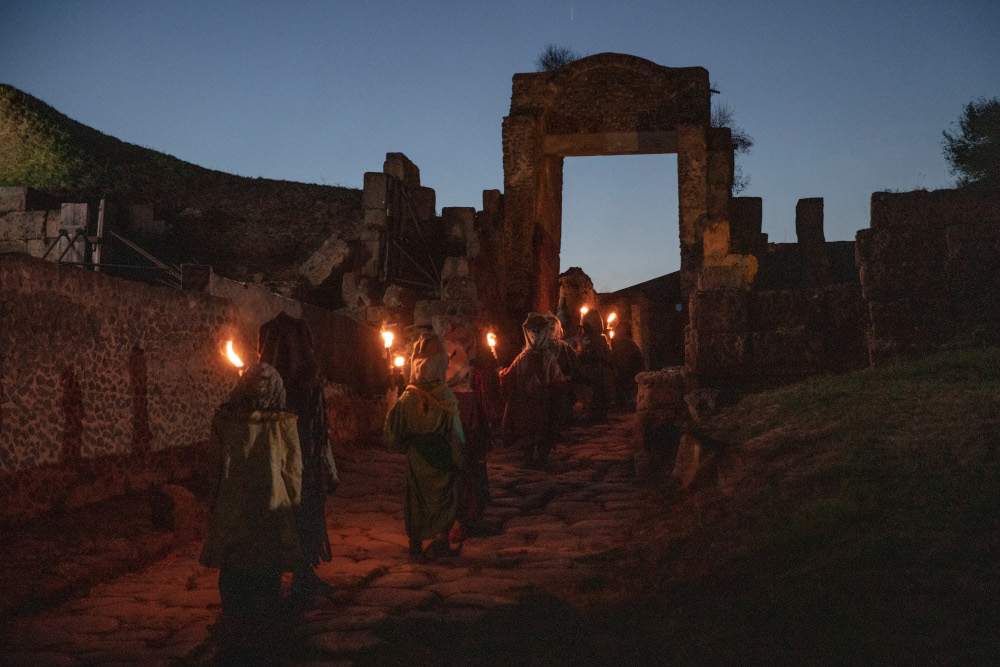Contemporary art arrives at Pompeii Archaeological Park with Egyptian artist Wael Shawky
At the conclusion of the production started in the winter of 2020-2021, the new film work by Egyptian artist Wael Shawky (Alexandria, Egypt, 1971), entitled I Am Hymns of the New Temples, two unpublished works on paper and asculptural work that refers to anancient theatrical mask, used in the scenic and choreographic elements of the film, have arrived at the Archaeological Park of Pompeii. The work, winner of the PAC - Plan for Contemporary Art 2020 call promoted and supported by the General Directorate for Contemporary Creativity, will have its international premiere at the Archaeological Park of Pompeii in early 2023. It is the result of a collaboration between the Ministry of Culture and the Pompeii Archaeological Park in the context of Pompeii Commitment. Archaeological Matters, the first long-term project dedicated by the Park to contemporary arts and cultures co-devised by Massimo Osanna and Andrea Viliani, and co-curated by the latter with Stella Bottai, Laura Mariano and Caterina Avataneo, with Sole Project Manager Silvia Martina Bertesago, Archaeological Park of Pompeii Archaeological Officer, and scientific and organizational support from Anna Civale.
Shot in the summer of 2022 in the ruins of Pompeii, Shawky’s new film work shows what surfaces at the thresholds between different cultures, both ancient and contemporary, that make the Mediterranean a true theater where different narratives and myths overlap. Basing his extensive narrative on rigorous archival research, Shawky re-stages the even contradictory stratifications of history, depicting the genesis of a plurality of ancient legendary tales through the multiple versions that can be traced of the same tale on the shores of the Mediterranean.
Pompeii’s archaeological remains testify to the intricate interweaving and complex configuration of Mediterranean cultures. Indeed, ancient Pompeii was home not only to temples related to the Greco-Roman religion, but also to Egyptian cults (the Temple of Isis was unearthed at the beginning of the Grand Tour with its stuccoes, statues, frescoes and furnishings) and to the mystery rites of Mithras, Cybele, Attis, with countless traces of iconography evidenced by the archaeological areas used as sets, including Praedia of Julia Felix, House of the Orchard, Odeion, Temple of Vespasian (Genius Augusti), Temple of Isis, Necropolis of Porta Nocera, Basilica.
Shawky offers a hypothetical reading of ancient myths of gods, fictional characters or real historical figures, embodied in the ensemble of temples, sculptures, frescoes, mosaics but also Pompeian landscapes in constant transformation. By uniting imaginative and multi-species beings and humans, plants and animals in his fantastical representation, Shawky understands Pompeii as a multiverse of narrative and historical potential and as both a cultural and natural ecosystem available for metamorphosis and interpretation.
The new film I Am Hymns of the New Temples represents the culmination of the artist’s research between art and cinema, which began with his previous film trilogies Cabaret Crusades (2010-2015) and Al Araba Al Madfuna (2012-2016). In them he had already placed events and characters from the Egyptian and Middle Eastern traditions in dialogue with a contemporaneity shaken by seemingly irresolvable contrasts, again recounting the events of the Crusades from the Arab historiographical perspective, and using puppets instead of historical characters, or entrusting children disguised as adults with the telling of the ancient traditions of the village Al Araba Al Madfuna near Abydos. In this way Shawky reshapes historical events by bringing out ancestral spiritual dynamics. As the artist himself says, his desire in making his filmic works is that they be “sufficiently precise in detail that they seem to actually exist somewhere.”
I Am Hymns of the New Temples represents the first work produced as part of the Pompeii Commitment project. Archaeological Matters, a platform dedicated to the formation of the contemporary art collection of the Archaeological Park of Pompeii.
“True archaeology is always looking with new eyes at the ancient we already think we know,” says Pompeii Archaeological Park director Gabriel Zuchtriegel. "This is why Pompeii Archaeological Park believes so strongly in the value of the dialogue between archaeology and contemporary art, a dialogue capable of listening to common stories, bringing the geographical and chronological terms of a history closer together, in which telling the ancient simply means telling the contemporary to us.
Photo by Amedeo Benestante © MIC - Archaeological Park of Pompeii.
 |
| Contemporary art arrives at Pompeii Archaeological Park with Egyptian artist Wael Shawky |
Warning: the translation into English of the original Italian article was created using automatic tools. We undertake to review all articles, but we do not guarantee the total absence of inaccuracies in the translation due to the program. You can find the original by clicking on the ITA button. If you find any mistake,please contact us.




























